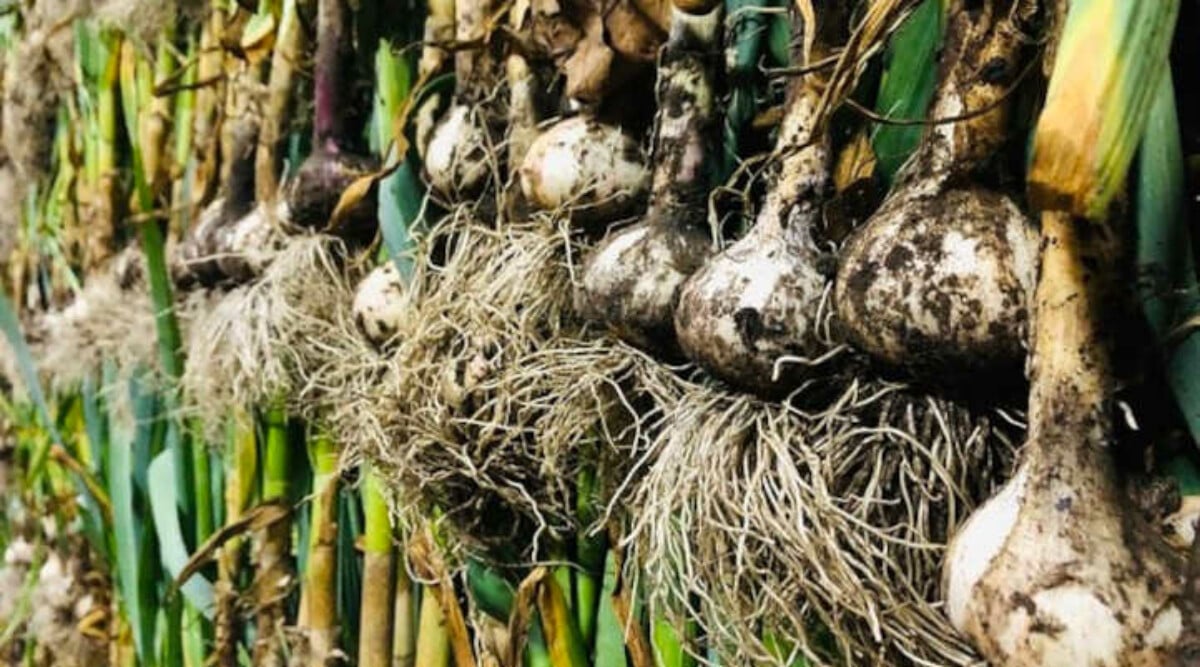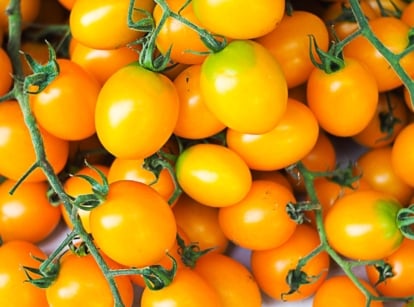Curing Garlic For Long-Term Storage
Curing garlic is an essential element of the harvesting process. Here, we explore all methods used to cure hardneck and softneck varieties!

Contents
Grow a garlic crop, and you’ll have a garlic harvest. Then it’s time to preserve the flavor and shelf life by curing garlic bulbs. There’s nothing better than freshly harvested garlic, but cured garlic cloves have all the delicious flavor that you want out of your vegetable garden.
There are multiple ways to cure garlic, each with its benefits. How you cure could determine how you store garlic. How much space you have also influences the curing procedure, and the type of garlic you’ve grown does too.
So let’s discuss the different ways to cure garlic, and talk about all you need to know while the garlic bulbs dry. Maybe you’re considering whether or not to grow garlic at all! In that case, before you plant those garlic plants, read this guide to see which curing plan works best for your situation.
Types of Garlic Bulbs

There are two basic types of garlic: hardneck and softneck. The variety of garlic you’ve grown has a huge impact on how the garlic dries. So before we get into curing methods, let’s cover garlic types first.
Hardneck Garlic
One of the ways to know whether you are growing hardneck garlic is to look at the stem. The stem of a hardneck variety comes out of the center of the fully mature bulbs in a thick cylinder. These are garlic scapes. The leaves of hardnecks are upright, and from them blooms one very robust flower. Hardnecks have a larger garlic bulb and each has fewer garlic cloves. The stiff stem goes all the way through the center of the garlic bulb to its root zone.
Elephant garlic is one popular hardneck variety that a lot of gardeners enjoy growing. This garlic plant has large bulbs with only 4 individual cloves. Many of the garlic varieties with purple stripes are also of the hardneck type. One thing to note about hardnecks is they don’t store as long as softneck garlic, and they don’t need to be cured as long. Typically, hardneck varieties are only cured for a couple of weeks as the neck will be much drier at the time of harvest than softneck varieties.
Softneck Garlic
Fresh garlic of the softneck variety is what is most commonly sold in grocery stores. Instead of scapes, these have green leaves that get yellow or brown tips and fall over when it’s time to harvest garlic. There are many more segments per bulb, and in their whole state, they tend to keep much longer. Because their necks are more flexible, softnecks need curing for longer-term storage. The outer wrapper of the bulb is also not as tough as hardneck types and they have a smaller bulb size overall.
Artichoke garlic is the softneck variety most commonly grown commercially. Fully mature, they can have up to 20 cloves. They are grown for their viability, making it possible to grow an entire crop successfully. This is the garlic we all know from the grocery store.
Before you decide to spend time and energy curing, make sure you have a variety that needs it. Some hardneck varieties do not store for long enough for the curing process to be a viable option. After a few months, cloves can shrivel up. Set these varieties aside for more immediate use. Similarly, damaged cloves can mess up the cure for good cloves. You’ll want to sort these out before you set up your curing station.
Garlic Curing Preparations

To start, you have to know how and when to harvest garlic. You can harvest garlic by timing, knowing that when garlic grows it will be ready at a certain time of year. For softnecks, when a third of the leaves turn yellow it’s time to get your digging fork out and begin harvesting garlic. Always check one bulb before harvesting the rest. If you tested one and found it not large enough, when half of the leaves are yellowed, it’s time to pull the rest.
Select garlic that can be cured. Those that have damaged, soft cloves should be removed and used within a few hours to a few days. Any sprouting garlic should also be taken out of your curing bunch. Save them for your early summer or fall planting. All the cloves that have garlic sprouts should either be consumed or become planted garlic later.
Prepare them for curing. Before you cure, clean dirt off the roots, leaving them intact along with the leaves. As you clean and harvest, keep them out of direct light. Make sure not to bruise or damage them when moving and preparing them. They’re sensitive and can bruise easily.
Garlic Curing Methods

There is nothing like cured garlic you grew yourself. So let’s talk about different methods for extending your bulb’s shelf life. Then you can have your own garlic whenever you want it! One thing to note about every method here is none of your bulbs should be in direct sunlight, and damaged bulbs should not accompany your other garlic ready for curing.
Bunch Curing
Hang bunches from ceiling hooks or rafters to cure for two weeks. In this situation, you’ll need a space large enough to hold your bunches, and good air circulation. This could come in the form of a small electric fan or a larger box fan, but they should be on the entire time you cure. The temperature in your curing room should be around room temperature to 80 degrees Fahrenheit. Maintain a relative humidity of 60 to 70%. Any more than that can cause mold or will require more time to cure (up to six weeks).
Once the papery skin as well as the leaves and roots are completely dry, they’re ready for long-term storage. This method is best for those with a small harvest, and ample curing space. When you bunch garlic, note that smaller bunches will be completely cured within about three weeks. Larger bunches will get less air movement and take longer to cure.
Rack Curing
Lay garlic on a rack horizontally to cure whole bulbs. The same conditions needed in vertical curing apply here. Find a well-ventilated location in the 70 to 80-degree range. Provide moderate humidity and good air movement. When the bulbs are fully cured, the paper wrappers will be dry and brittle.
Unless you are growing garlic on a large scale, this may not be the best option for you. Racks aren’t widely available and often need to be constructed. They also take up a lot of space. If they’re constructed improperly, they can block the air circulation needed for curing. Still, if you have access to a rack or the materials to make one this is a viable curing option. This method takes up to 2 weeks, though, making the space needs a trade-off for less time.
Net Curing
Hang each bulb in a vertical net, fencing, or chicken wire. This method is similar to the bunch curing method, but it saves a great deal of space. By using vertical netting, you condense the space into one plane that can hang in a kitchen out of immediate light. This method can cure a lot more garlic than you might cure with the bunch method. As with the other modes, you need constant good air circulation and mid-range humidity.
You’ll have “walls” of garlic this way. Keep your box fan or electric fan on for 3 to 4 weeks, when the bulb wrappers are dry and brittle, they’re ready. Then prepare each bulb for long-term storage.
Braiding or Trimming Bulbs
Once your garlic is cured, either trim the leaves off bulbs or braid them. Braiding leaves gives you the longest storing garlic possible. It looks nice and gives them a lovely aesthetic appeal that trimmed bulbs might not have. To braid them, trim off the roots and remove any remaining dirt from the bulb. Then tie three bulbs together with twine. Do a basic braid here, keeping it simple with just three bulbs or incorporating others to make a more complicated tiered design. Then tie the end with twine and hang the bulbs in your kitchen where you’ll access them for cooking.
Trimming bulbs has its benefits as well. Not only is it a faster way to clean garlic for storage, but it also prevents the peeling of garlic skin. Here, use a sharp scissor or pruner and cut about one inch above the top of the bulb. Then store each bulb in mesh bags. Remove the largest bulbs for later planting, as small bulbs will produce smaller bulbs in later harvests. The biggest cloves are what you are looking for.
Stand-Curing Hardneck Garlic
Due to their stiff necks, hardneck garlic can sometimes be stood on its neck to cure. This method looks odd and is best done in an area with no wind and moderate humidity. Fan out the leaves in all directions to help provide some stability, and stand it up on its stiff neck with the bulb in the air. This method is not the best for people with pets or children who might knock over the bulbs, as you risk potential bulb bruising, but it can be an effective solution if you don’t have a whole lot to cure.
Garlic Storage

Whether you store garlic for cooking or for making a garlic spray that will help you maintain your garden, you have plenty of options. You can freeze garlic in freezer bags in almost any form outside of the skin. Peeled cloves, minced, chopped: all of these can be frozen. You can even freeze the garlic scapes. All of these frozen garlic parts will keep for up to 6 months.
One delectable storage method for garlic is preserving it in oil. You’ll need to cook it first before you store garlic in oil because bacteria present on the skin can develop and cause botulism. Boil peeled garlic in water for two minutes. Then drain them and put them in olive oil with your choice of spices. They’ll keep for two months at room temperature.
Garlic powder is mystifying to those who don’t know how to process it. But it’s pretty simple to make as long as you have a dehydrator nearby. Slice peeled garlic thinly and lay it out in a dehydrator at 150 degrees until it’s brittle enough to crush in your hand easily. Then grind it to your desired consistency. A mortar and pestle or blender works for this. Store it in an airtight container, and you’ll have your garlic powder for up to two years.
Frequently Asked Questions

Q: Is curing garlic necessary?
A: It’s not, but curing homegrown garlic is a great way to preserve the flavor and shelf life of these bulbs.
Q: How long does garlic need to cure?
A: At least two weeks is needed to cure garlic and up to six weeks for some softneck varieties.
Q: Can you eat garlic immediately after harvesting?
A: Indeed, you can, but the flavor will be much lighter than garlic that has been cured properly. Hardneck varieties should not need as much curing and can be eaten immediately.








